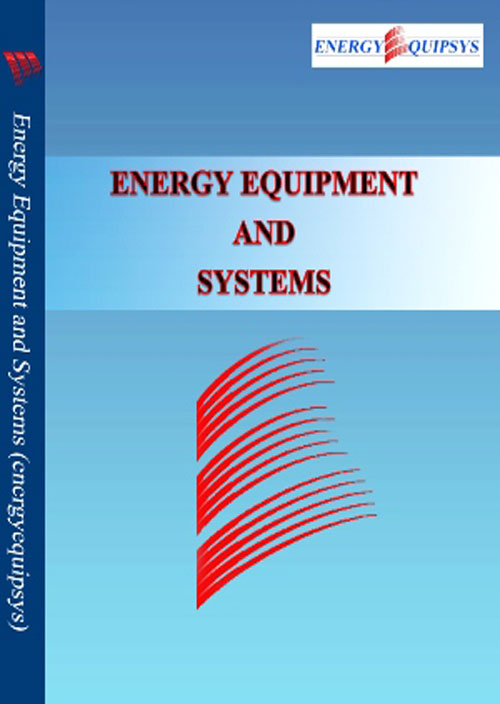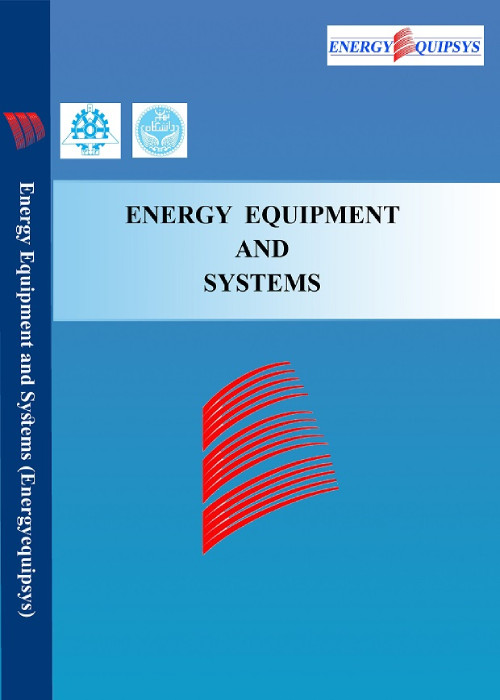فهرست مطالب

Energy Equipment and Systems
Volume:9 Issue: 2, Spring 2021
- تاریخ انتشار: 1400/04/06
- تعداد عناوین: 6
-
-
Pages 107-116
Regarding the world's energy status and the irreparable damages caused by the use and dependence on fossil fuels, the design and construction of buildings with zero energy buildings (ZEB) has been considered in recent years. Moving towards the use of renewable energy sources, such as solar energy by using photovoltaic panels to provide energy in the construction sector, is a global imperative in recent decades. In zero energy buildings, due to the limited available space to occupy the roof by photovoltaic panels, considering the best layout of panels and different technologies to access the highest output production capacity on one hand and cost-effectiveness of the project, on the other hand, are important. The paper presents a basic investigation on optimal layouts of photovoltaic. In this paper, all of the obtained information has been compared from a statistical inference Approach. Also, the obtained information about power capacity and areas of the panels, regarding the layout of the panels, was analyzed by inferential statistics, due to the limits of the installation space, the layout of the panels in the directions (North-South) and (East-West) with a 15 degree angle, has the highest output power capacity, which according to the analysis done by the software, due to insignificant differences of these two layouts in power capacity, and lower required area in eastern-western layout with a 15 degree angle, this layout was evaluated more economical.
Keywords: Zero Energy Building, Photovoltaic, Renewable Energy, Statistical Inference -
Pages 117-125Energy analysis in agriculture plays a significant role in developing the human perspective towards agricultural ecosystems, which enhances the quality of decision-making and planning in agricultural management and development. In this study, according to data obtained from the agricultural centers of the Varamin region, the different levels of forage maize cultivation were classified into three levels, less than one hectare (A1), between one to three hectares (A2), and more than three hectares (A3). By calculating the amount of input and output energy, energy evaluation indices, such as energy use efficiency, energy productivity, and net energy, were determined and compared at the different levels of utilization. According to the results, an increase in the cultivation levels, the human labor, machinery, diesel fuel, oil and nitrogen fertilizer (N) energies decreased, but the water for irrigation, phosphate (P2o5) fertilizer, potassium (K2O) fertilizer, pesticides, herbicides, and seed energies increased. On the other hand, the maximum amount of energy consumed at each level was calculated for nitrogen fertilizer inputs and diesel fuel, respectively, and the lowest ones were calculated for pesticides and potassium fertilizer, respectively. According to the results, the energy use efficiency in the different levels of utilization for A1, A2, and A3 levels was 11.02, 21.97, and 22.94, and the energy productivity for these levels was 1.37, 6.87, and 11.47 kg MJ-1, respectively. Finally, net energy was calculated as 349175.43, 458157.76, and 478208.72 MJ ha-1, respectively.Keywords: Energy Productivity, Energy Use Efficiency, Net Energy, Farm size
-
Pages 127-143In this study, an off-grid PV system is optimized to supply a Conex electricity demand in the top ten earthquake-prone cities using mixed-integer linear programming techniques. The stand-alone photovoltaic system is designed by a photovoltaic array, a cooling/heating system, battery banks, an inverter, and a charge controller. For determining the optimum size and specifications of the system components such as PV panel, HVAC coefficient of performance, by considering two objectives of the study, a mixed-integer linear programming method is used. These conflicting objectives are the probability of lack of power and total cost of the system. The weighted factor method is utilized, and final optimized systems are achieved using MATLAB 2019b. Using the weighted factor method, several optimum solutions, in which the importance of objectives are different from each other, are obtained for each case concerning objectives. The suggested model is optimized for ten earthquake-prone cities globally, while it can be utilized for any location. The Pareto frontiers are presented to show the trade-offs between two objective functions. The average cost of off-grid PV system supplied electrical power is from about 1000$ for lima (subtropical desert climate) to 4000$ for Tokyo and Osaka (humid subtropical). Analysis of obtained results demonstrates that the system is suitable for all of the considered cities. It can supply the load demand of an off-grid Conex with a loss of power supply probability as low as 1%.Keywords: Off-Grid PV System, Multi-objective optimization, Mixed-Integer Linear Programming, Earthquake-Prone Cities
-
Pages 145-158Hot machining is a type of cutting operation that an external heat source is used to pre-heat and consequently reduce the yield strength of the workpiece material. In this study, the conventional and hot turning of AISI630 hardened stainless steel, which is widely used in energy equipment, aerospace, and petrochemical industries, have been evaluated in both numerical and experimental methods. Simulation of the turning process is carried out by finite elements method (FEM) using AdvantEdge software. To predict chip morphology and cutting forces, the 2D and 3D FEM analyses have been used, respectively. The numerical analysis showed that hot turning in 300°C causes a reduction of 28% in cutting forces and consequently decreases stressed on the cutting tool. It is found that the main factor affecting the fluctuations of the cutting forces in turning of hardened AISI630 is the saw-tooth formation phenomenon (chip segmentation) as well as the shear band generation due to thermal softening of the workpiece material. Furthermore, the relation between cutting force fluctuation and the machined surface roughness has been investigated applying numerical analysis and experimental data. The results of roughness measurement revealed that hot turning in 300°C reduces the machined surface roughness up to 23%. In addition, it has been observed that hot turning technique decreases side flow and surface damages in comparison to conventional turning.Keywords: Hot Turning, Surface roughness, Finite elements method, Cutting Force Fluctuation, Tool Wear
-
Pages 159-172Today, the use of hybrid fuels in internal combustion engines has been considered to decrease the level of environmental pollutants. Among the various additives used to increase the efficiency and decrease pollution of Compression Ignition (CI) engines, alcohols especially methanol and ethanol have a special place. In this work, a one-dimensional, thermodynamic and two-zone model was used to evaluate the performance and emission of a compression ignition engine using ethanol and methanol in two volumes of 5% and 10% with diesel fuel by using engineering software such as GT-Power. Also, an exergy assessment is performed to study the exergy efficiency and exergy destruction of the engine for desired cases. The results show that the use of diesel fuel with alcoholic compounds reduces the heating value of the fuel compared to the D100 as well as the maximum brake torque and power and significantly reduces the engine exhaust emissions. This reduction is at most equal to 15%, which is of particular importance with respect to pollutants such as and CO. The exergy analysis shows that addition of alcoholic compounds such as ethanol and methanol by 5% and 10% to diesel fuel reduces braking power, it also reduces input exergy, which decreases exergy destruction and decreases the exergy efficiency by a maximum of 1.1%.Keywords: Ethanol, Methanol, Exergy Analysis, One-Dimensional Model, Compression Ignition Engine
-
Pages 173-190
This paper evaluates the performance of a concentrating photo-voltaic thermal (CPVT) hybrid system for space heating, providing hot water, and grid-connected (GC) electricity generation in the city of Isfahan, Iran. The GCCPVT system is a ground-mounted 5.63 kWp rated power system oriented in a north-south direction to achieve the maximum power output. The annual and monthly modeling of the system is performed by Polysun® simulation software. The system specifications are described and the heating and electrical energy demand of the building are determined. The GC-CPVT performance simulation is then conducted based on the meteorological data of the location. The monthly simulation results of the GC-CPVT system in the studied location show that the yield factor varies from 138.8 to 183 kWh/kWp, the reference yield from 170.3 to 253.5 kWh/kWp, and the performance ratio from 70.3 to 82.2%. The maximum annual AC electricity generated is 10752 kWh. Furthermore, the CPVT system generates a considerable amount of heat. The annual solar fraction values for covering domestic hot water and space heating are achieved 78.3% and 35.3%, respectively. The monthly solar fraction covered by the CPVT system also varies from 32 to 100%. The environmental performance of the GC-CPVT system indicates that the contribution of such a system to CO2 emission reductions exceeds 8 tons of CO2 per year.
Keywords: Concentrating Photovoltaic Thermal, Grid-Connected, Residential Heat, Performance Simulation, CO2Saving


